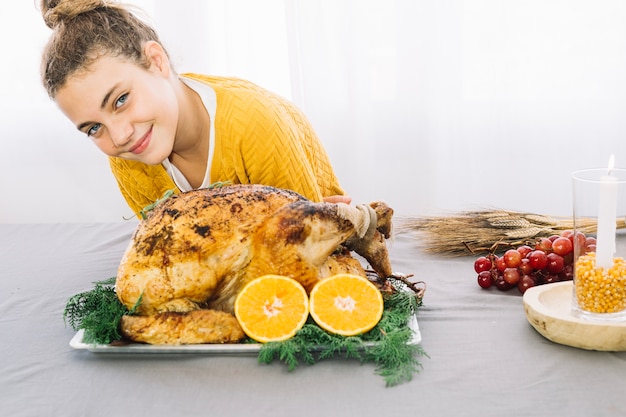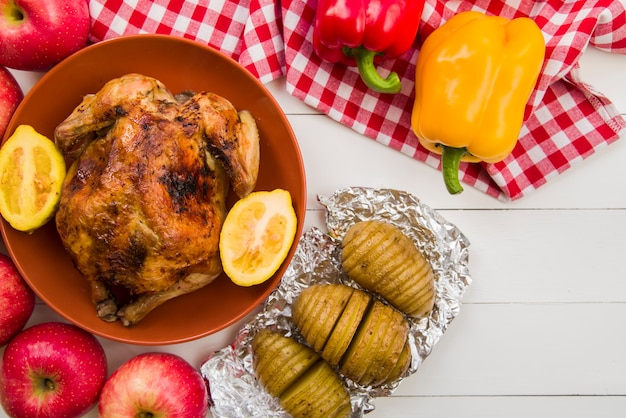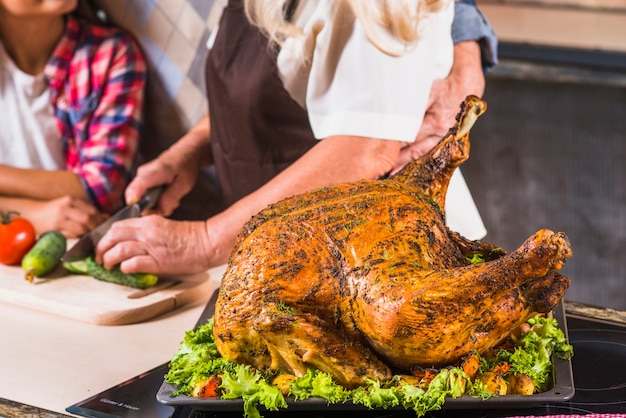A 21lb turkey? That's a real whopper! You're probably picturing a magnificent bird taking center stage at your holiday feast, and you're wondering: "How long will this giant take to cook?" Trust me, I've been there, staring down a turkey bigger than my toddler, and feeling the pressure of getting it perfectly cooked. But fear not, my fellow turkey-wrestling chef, I'm here to guide you through the process. Get ready to embrace the journey, and I guarantee, with a little know-how, your 21lb turkey will be a culinary triumph.
Part 1: Understanding the Variables

The truth is, there’s no one-size-fits-all answer to the "how long" question. It's like baking – there are ingredients and techniques that can affect the outcome, and cooking a turkey is no exception. The size of the bird, the oven temperature, and even the cooking method all play a role in determining the cooking time. Let's break down these key factors and understand how they impact our massive bird.
1.1: The Weighty Matter
Imagine a 21lb turkey as a colossal cake. You wouldn't expect a small oven to bake it in the same time as a mini cupcake, right? The same goes for our turkey. That extra poundage means more meat to cook through, and that takes time. Think of it as a marathon for your oven, not a sprint. More time is needed to ensure every bit of that delicious meat reaches a safe internal temperature.
1.2: Oven Temperature: A Balancing Act
Imagine a hot oven as a roaring fire, capable of quickly browning and cooking the outside of your turkey, while a lower temperature is like a gentle simmer, gradually cooking the meat from the inside out. Both have their merits. A higher temperature might seem tempting for a faster cook, but be cautious - it can also lead to dryness. A lower temperature might take longer, but it's typically gentler on the meat, resulting in a more succulent bird.
1.3: Cooking Method: Exploring the Options
The world of turkey cooking is far more diverse than you might think. There's roasting, smoking, deep-frying, even slow-roasting – each with its unique approach and required time commitment. Roasting typically involves higher heat and a shorter cooking time, while smoking is a low and slow process requiring patience and meticulous temperature control. Even something as simple as whether you choose to stuff your turkey or not can alter the cooking time. It's essential to understand your method and its specific requirements before you embark on your turkey adventure.
Part 2: Estimating Cooking Time

Now, let's tackle the big question: How long will your 21lb turkey take to cook? While we can't give you an exact time without knowing the specifics of your method and oven, there are general guidelines to help you get started. It's like having a roadmap for your culinary journey, but remember, flexibility is key.
2.1: The Rule of Thumb
A common rule of thumb for roasting turkeys is 15 minutes per pound. So, for a 21lb bird, you'd be looking at approximately 315 minutes, or just over 5 hours. However, this is just a starting point, and you might need to adjust based on the factors we've discussed.
2.2: Adjusting for Temperature
Remember the analogy of a hot oven being a roaring fire? If you're cooking at a lower temperature, think of it as a slow burn. You'll need to add some time to the rule of thumb. A typical roasting temperature is 325°F (160°C), and for that, you might add 30 minutes or more to the initial estimate.
2.3: The meat thermometer: Your Faithful Guide
The real hero of the turkey-cooking saga is the trusty meat thermometer. It's your compass, guiding you towards culinary perfection. The USDA recommends cooking your turkey to an internal temperature of 165°F (74°C) in the thickest part of the thigh. This ensures the entire turkey is cooked through and safe to eat. This is why it's crucial to invest in a reliable meat thermometer; it's like having a second pair of eyes, ensuring your turkey is cooked to perfection, not just looking good on the outside.
Part 3: Factors Affecting Cooking Time

Let's dive a little deeper into the specifics that can influence how long your turkey needs to cook. Think of it as fine-tuning your recipe, adjusting for the unique personality of your turkey and your cooking setup.
3.1: The Stuffing Dilemma
Stuffing your turkey can be a delicious tradition, but it introduces a new element to the cooking equation. The stuffing absorbs heat from the turkey, essentially creating a heat sink. This means the turkey will take longer to reach that crucial internal temperature. To avoid a soggy mess, it's generally recommended to cook your stuffing separately, and fill the turkey just before serving.
3.2: Turkey Shape: Round or Flat
Just like you wouldn't expect a flat pancake to bake in the same time as a thick, round cake, the shape of your turkey matters too. A flatter, broader turkey allows for better heat circulation, resulting in more even cooking. A round, plump bird will take longer to cook through. So, if your turkey is particularly round, consider adding a few extra minutes to your cooking time.
3.3: Oven Size: The Right Fit
Imagine a small oven as a cramped kitchen, making it difficult for the heat to circulate freely. This can impact your turkey's cooking time. If you have a small oven and a large turkey, it might need more time to cook evenly. Give your turkey plenty of space in the oven for proper heat distribution.
Part 4: Troubleshooting Common Turkey Cooking Issues
Even the most experienced cooks can encounter challenges when tackling a turkey. Don't worry, we're here to equip you with the knowledge to troubleshoot any bumps in the road. Think of it as a toolbox for dealing with any cooking curveballs.
4.1: Too Dark, Too Fast
If you notice your turkey's skin is browning too quickly before the internal temperature is where it needs to be, a simple solution is to cover the bird with foil. This acts like a shield, reflecting the heat and preventing the skin from burning. It's like giving your turkey a little blanket to keep it from getting too crispy too soon.
4.2: Uneven Cooking
If your turkey isn't cooking evenly, try rotating it halfway through the cooking time. This helps to ensure all sides receive equal heat. It's like giving your turkey a little dance in the oven to ensure even browning and cooking.
4.3: Turkey Done, Stuffing Not
If your turkey is cooked, but the stuffing isn't quite ready, transfer it to a baking dish and continue cooking it in the oven. Keep a close eye on it, and don't let it burn. A little extra time in the oven can ensure your stuffing is perfectly cooked and ready to enjoy alongside your perfectly cooked turkey.
Part 5: Tips and Tricks for a perfect turkey
Now that we've covered the basics and tackled some potential issues, let's move on to the fun part – maximizing the flavor and juiciness of your 21lb bird. Think of this as the secret sauce, the little extra touches that can transform your turkey from good to amazing.
5.1: Brining: The Magic Moisture Boost
Brining is a simple, yet incredibly effective technique that can elevate your turkey to another level. It involves soaking the bird in a salt water solution, essentially hydrating the meat from the inside out. The result? A juicy, flavorful turkey that practically melts in your mouth. However, a word of caution: If you're stuffing your turkey, it's best to avoid brining as it can lead to a soggy mess.
5.2: Seasoning: The Flavor Explosion
Don't be shy when it comes to seasoning your turkey. A good quality herb blend, salt, pepper, garlic powder, onion powder – they're all your friends! Experiment with different flavors to find your perfect combination. A little spice goes a long way, adding depth and complexity to the overall taste of your bird.
5.3: Roasting with a Twist: Adding Flavor and Moisture
Think outside the box! Instead of just placing your turkey in a roasting pan, try roasting it on a bed of vegetables like onions and carrots. Not only will this add flavor to the turkey, but the vegetables will also release moisture, helping to keep the meat moist. Another option is to roast your turkey with a pan of water underneath to create steam. Think of it as a mini sauna for your turkey, helping to keep it juicy and succulent.
Part 6: The Resting Period: Letting the Turkey Relax
After your turkey has spent its time in the oven, it needs a little "me time" before you carve it. Allow it to rest for at least 30 minutes, covered with foil. This resting period allows the juices to redistribute throughout the meat, resulting in a juicier and more flavorful turkey. Think of it as a little spa day for your turkey, allowing it to recover and soak in the flavor before it's time to shine.
Part 7: Carving Your Turkey: A Skillful Art
The time has come to unveil your culinary masterpiece! A sharp knife is essential for this task. If you're a carving newbie, there are plenty of online tutorials available to guide you through the process. Practice on a smaller chicken first to get comfortable with the techniques before tackling your impressive 21lb bird.
Part 8: Serving Your Turkey: The Grand Finale
Now, the moment you've been waiting for! Time to present your perfectly cooked turkey to your guests. Make sure you have plenty of gravy, side dishes, and of course, cranberry sauce, to accompany your impressive bird. It's the culmination of your efforts, and you deserve to enjoy the fruits of your culinary labor.
Part 9: turkey leftovers: Don't Waste Them
Don't let your hard work go to waste! Leftover turkey is a delicious canvas for creativity. Turn it into a hearty turkey sandwich, a comforting turkey soup, or a flavorful turkey salad. Get creative in the kitchen and give your leftover turkey a new life.
Part 10: FAQs
10.1: How Do I Know My Turkey Is Done?
As we've discussed, the trusty meat thermometer is your best friend. Insert it into the thickest part of the thigh, and once the temperature reaches 165°F (74°C), your turkey is ready to be enjoyed.
10.2: Can I Stuff My Turkey?
You can stuff your turkey, but it's best to cook the stuffing separately to ensure it's cooked through properly. If you choose to stuff your turkey, make sure it reaches an internal temperature of 165°F (74°C).
10.3: What If My Turkey Is Overcooked?
Overcooked turkey can be dry. To salvage the situation, try adding some gravy or sauce to add moisture and flavor. Alternatively, use the leftover turkey in a different dish, like a turkey sandwich or a casserole.
10.4: How Long Can I Keep Leftover Turkey?
Store leftover turkey in an airtight container in the refrigerator for up to 4 days.
10.5: Can I Freeze Leftover Turkey?
Yes, you can freeze leftover turkey for up to 2 months. Wrap it tightly in freezer paper or plastic wrap to prevent freezer burn.
Part 11: Conclusion
Cooking a 21lb turkey is an adventure. It requires a bit of planning, patience, and some know-how. But with the right information and a little confidence, you can create a culinary masterpiece that will impress your guests and leave everyone wanting more. Remember, it's about the journey, the process, and the joy of sharing a delicious meal. So, relax, embrace the challenge, and enjoy the experience of crafting a perfect holiday turkey.
Everyone is watching

Corn on the Cob: The Ultimate Guide to Perfectly Cooked Ears
Healthy MealsAh, corn on the cob. Just the name evokes images of sunny days, barbecues, and that sweet, juicy flavour that ...

Perfect Pork Roast Oven Cooking Time: A Guide to Delicious Results
Healthy MealsThere's something truly satisfying about a perfectly roasted pork. The aroma alone is enough to make your mout...

Ham Cooking Time: How Long to Bake, Smoke, or Boil a Delicious Ham
Healthy MealsAh, ham. It's a classic, isn't it? A real crowd-pleaser, especially around holidays. And when done right, it'...

Scallops: The Ultimate Guide to Perfect Cooking
Healthy MealsAh, scallops. Those delicate, sweet, and utterly delicious morsels of the sea. They hold a special place in my...

Spaghetti Squash: The Ultimate Guide to Cooking and Serving
Healthy MealsRemember that time you saw spaghetti squash at the supermarket, looking all bumpy and strange, and thought, "W...
